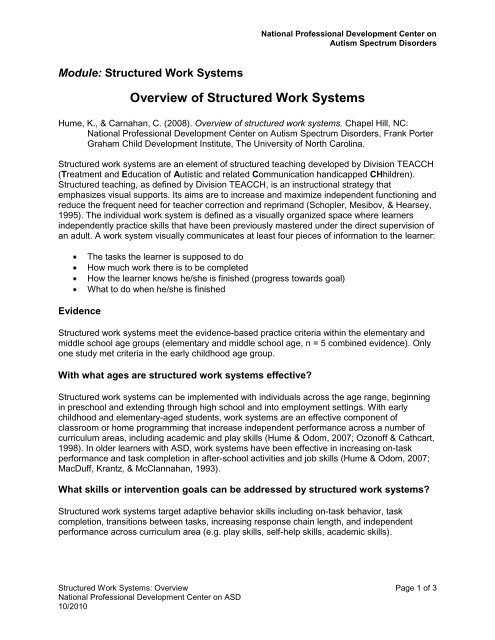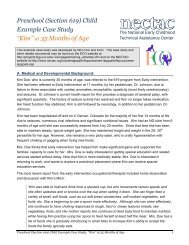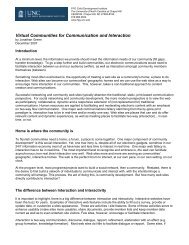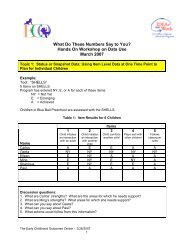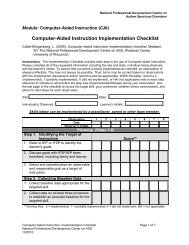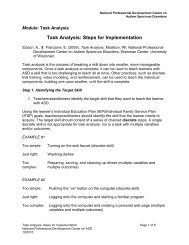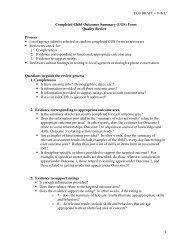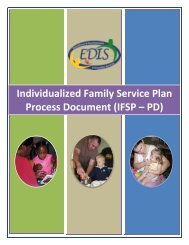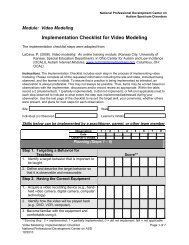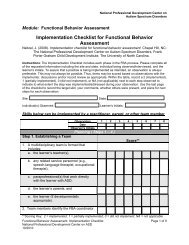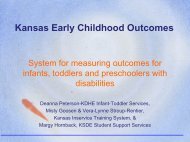Overview of Structured Work Systems - National Professional ...
Overview of Structured Work Systems - National Professional ...
Overview of Structured Work Systems - National Professional ...
Create successful ePaper yourself
Turn your PDF publications into a flip-book with our unique Google optimized e-Paper software.
<strong>National</strong> Pr<strong>of</strong>essional Development Center on<br />
Autism Spectrum Disorders<br />
Module: <strong>Structured</strong> <strong>Work</strong> <strong>Systems</strong><br />
<strong>Overview</strong> <strong>of</strong> <strong>Structured</strong> <strong>Work</strong> <strong>Systems</strong><br />
Hume, K., & Carnahan, C. (2008). <strong>Overview</strong> <strong>of</strong> structured work systems. Chapel Hill, NC:<br />
<strong>National</strong> Pr<strong>of</strong>essional Development Center on Autism Spectrum Disorders, Frank Porter<br />
Graham Child Development Institute, The University <strong>of</strong> North Carolina.<br />
<strong>Structured</strong> work systems are an element <strong>of</strong> structured teaching developed by Division TEACCH<br />
(Treatment and Education <strong>of</strong> Autistic and related Communication handicapped CHhildren).<br />
<strong>Structured</strong> teaching, as defined by Division TEACCH, is an instructional strategy that<br />
emphasizes visual supports. Its aims are to increase and maximize independent functioning and<br />
reduce the frequent need for teacher correction and reprimand (Schopler, Mesibov, & Hearsey,<br />
1995). The individual work system is defined as a visually organized space where learners<br />
independently practice skills that have been previously mastered under the direct supervision <strong>of</strong><br />
an adult. A work system visually communicates at least four pieces <strong>of</strong> information to the learner:<br />
Evidence<br />
The tasks the learner is supposed to do<br />
How much work there is to be completed<br />
How the learner knows he/she is finished (progress towards goal)<br />
What to do when he/she is finished<br />
<strong>Structured</strong> work systems meet the evidence-based practice criteria within the elementary and<br />
middle school age groups (elementary and middle school age, n = 5 combined evidence). Only<br />
one study met criteria in the early childhood age group.<br />
With what ages are structured work systems effective<br />
<strong>Structured</strong> work systems can be implemented with individuals across the age range, beginning<br />
in preschool and extending through high school and into employment settings. With early<br />
childhood and elementary-aged students, work systems are an effective component <strong>of</strong><br />
classroom or home programming that increase independent performance across a number <strong>of</strong><br />
curriculum areas, including academic and play skills (Hume & Odom, 2007; Ozon<strong>of</strong>f & Cathcart,<br />
1998). In older learners with ASD, work systems have been effective in increasing on-task<br />
performance and task completion in after-school activities and job skills (Hume & Odom, 2007;<br />
MacDuff, Krantz, & McClannahan, 1993).<br />
What skills or intervention goals can be addressed by structured work systems<br />
<strong>Structured</strong> work systems target adaptive behavior skills including on-task behavior, task<br />
completion, transitions between tasks, increasing response chain length, and independent<br />
performance across curriculum area (e.g. play skills, self-help skills, academic skills).<br />
<strong>Structured</strong> <strong>Work</strong> <strong>Systems</strong>: <strong>Overview</strong> Page 1 <strong>of</strong> 3<br />
<strong>National</strong> Pr<strong>of</strong>essional Development Center on ASD<br />
10/2010
<strong>National</strong> Pr<strong>of</strong>essional Development Center on<br />
Autism Spectrum Disorders<br />
Module: <strong>Structured</strong> <strong>Work</strong> <strong>Systems</strong><br />
In what settings can structured work systems be effectively used<br />
<strong>Structured</strong> work systems have been used effectively in classroom settings, home settings,<br />
group home settings, and in one employment setting. <strong>Structured</strong> work systems are intended to<br />
be used as one component <strong>of</strong> comprehensive programming for individuals with ASD.<br />
Evidence Base<br />
The studies cited in this section provide the basis upon which this practice was determined to<br />
meet the NPDC on ASD’s criteria as an evidence-based practice. This list is not exhaustive;<br />
other quality studies may exist but were not included.<br />
Preschool<br />
Ozon<strong>of</strong>f, S., & Cathcart, K. (1998). Effectiveness <strong>of</strong> a home program intervention for young<br />
children with autism. Journal <strong>of</strong> Autism and Developmental Disorders, 28, 25-32.<br />
Elementary and Middle School Age<br />
Dettmer, S., Simpson, R., Myles, B., & Ganz, J. (2000). The use <strong>of</strong> visual supports to facilitate<br />
transitions <strong>of</strong> students with autism. Focus on Autism and Other Developmental<br />
Disabilities, 15, 163-170.<br />
Hume, K., & Odom, S. (2007). Effects <strong>of</strong> an individual work system on the independent<br />
functioning <strong>of</strong> students with autism. Journal <strong>of</strong> Autism and Developmental Disorders, 37,<br />
1166-1180.<br />
Panerai, S., Ferrante, L., & Caputo, V. (1997). The TEACCH strategy in mentally retarded<br />
children with autism: A multidimensional assessment. Journal <strong>of</strong> Autism and<br />
Developmental Disorders, 27, 345-347.<br />
Panerai, S., Ferrante, L., & Zingale, M. (2002). Benefits <strong>of</strong> the Treatment and Education <strong>of</strong><br />
Autistic and Communication Handicapped Children (TEACCH) program as compared<br />
with a non-specific approach. Journal <strong>of</strong> Intellectual Disability Research, 46, 318.<br />
Selected Additional References<br />
Krantz, P., MacDuff, M., & McClannahan, L. (1993). Programming participation in family<br />
activities for children with autism: Parent's use photographic activity schedules. Journal<br />
<strong>of</strong> Applied Behavior Analysis, 26, 137-138.<br />
MacDuff, G., Krantz, P., & McClannahan, L. (1993). Teaching children with autism to use<br />
photographic activity schedules: Maintenance and generalization <strong>of</strong> complex response<br />
chains. Journal <strong>of</strong> Applied Behavior Analysis, 26, 89-97.<br />
Mesibov, G., Shea, V., & Schopler, E. (2005). The TEACCH approach to autism<br />
spectrum disorders. New York: Plenum Press.<br />
<strong>Structured</strong> <strong>Work</strong> <strong>Systems</strong>: <strong>Overview</strong> Page 2 <strong>of</strong> 3<br />
<strong>National</strong> Pr<strong>of</strong>essional Development Center on ASD<br />
10/2010
<strong>National</strong> Pr<strong>of</strong>essional Development Center on<br />
Autism Spectrum Disorders<br />
Module: <strong>Structured</strong> <strong>Work</strong> <strong>Systems</strong><br />
Panerai, S., Ferrante, L., Caputo, V., & Impellizzeri, C. (1998). Use <strong>of</strong> structured teaching for<br />
treatment <strong>of</strong> children with autism and severe and pr<strong>of</strong>ound mental retardation. Education<br />
and Training in Mental Retardation and Developmental Disabilities, 33, 367-374.<br />
Schopler, E., Mesibov, G., & Hearsey, K. (1995). <strong>Structured</strong> teaching in the TEACCH<br />
system. In E. Schopler & G. Mesibov (Eds.), Learning and cognition in autism<br />
(pp. 243-268). New York: Plenum Press.<br />
<strong>Structured</strong> <strong>Work</strong> <strong>Systems</strong>: <strong>Overview</strong> Page 3 <strong>of</strong> 3<br />
<strong>National</strong> Pr<strong>of</strong>essional Development Center on ASD<br />
10/2010


